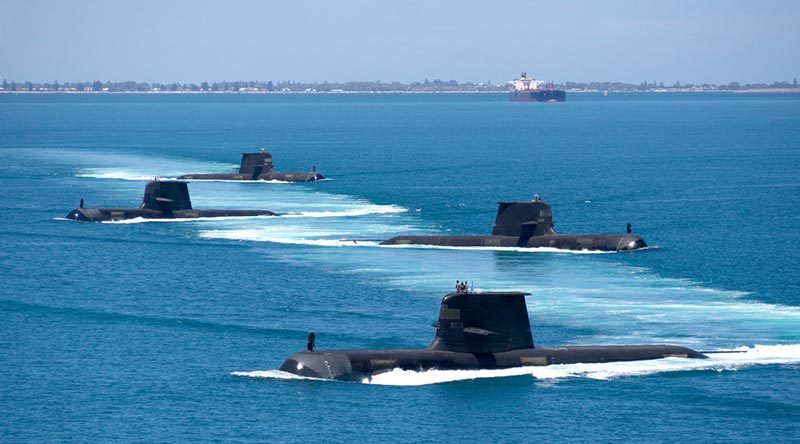Minister for Defence – Keynote address: Submarine Institute of Australia
Share the post "Minister for Defence – Keynote address: Submarine Institute of Australia"

Minister for Defence Lind Reynolds delivered a keynote address to the Submarine Institute of Australia this week – reproduced here unedited.
FILE PHOTO: Collins-class submarines HMAS Collins, HMAS Farncomb, HMAS Dechaineux and HMAS Sheean transition through Cockburn Sound, Western Australia. Photo by Lieutenant Chris Prescott.
Good morning ladies and gentlemen.
Firstly, I acknowledge the Wadjuk people of the Noongar nation, the traditional owners of the land on which I am speaking today.
As the Minister for Defence, I also pay my deepest respects to Aboriginal and Torres Strait Islander men and women who have served, and continue to serve our nation with such great distinction.
It is an absolute privilege to have this opportunity to address the 10th Biennial Submarine Institute of Australia Conference. I would particularly like to thank Mark Sander, Retired Royal Australian Navy Commodore and President of SIA, SIA’s Executive Committee members; and also all conference partners and sponsors.
SIA provides a really important public understanding of – and discussion about – Australia’s submarine requirements and also our capability.
These are extremely complex matters that can only be properly understood if explained in a national, global and also a generational context. The Australian Government is investing in our submarine capability – and also our anti-submarine capability – because we must. For our nation’s security, and also for our sovereign interests.
Let me first set the scene for the future of naval shipbuilding in Australia. We have entered a critical turning point in our nation’s history. For decades, Australia’s location at the junction of the Indian and the Pacific Oceans has been a strategic blessing. Providing generations of stability, peace and also prosperity.
But we now face the most consequential strategic realignment since the end of World War Two. And the Indo-Pacific – our region – is the epicentre of this change. Developments in our region will not only shape the future of Australia, they will also be pivotal in the course of the 21st century.
Issues front of mind for me are that major powers have become more assertive. That Strategic competition – primarily between the United States and China – is driving dynamics in our region. Across the Indo-Pacific, nations are modernising their militaries and also accelerating their preparedness for conflict. And regional military forces are developing and adopting disruptive technologies at a faster pace than ever before.
Traditionally, there was a decade-long warning period for a major conventional attack. Now, that no longer applies. Some nations are increasingly employing coercive tactics that seek to compromise sovereignty.
And this includes cyber attacks, foreign interference, supply chain disruption and economic pressure. And in this grey zone, influence becomes interference, economic co-operation becomes coercion, and investment becomes entrapment. And of course, the COVID-19 pandemic remains an active and very unpredictable threat.
In response to these trends, the Prime Minister and I launched the 2020 Defence Strategic Update in July. And then we spoke of the need for Australia to shift our posture in the region. In particular – in the context of our rapidly deteriorating security environment – and our need to shape, to deter, and to respond. And that is precisely what we are doing in our maritime domain.
The fact our home is girt by sea has significant implication for Australia’s strategic prospects, for our planning, and also for our priorities. We are a trade-dependent island continent, and our imports and exports are almost entirely transported by sea.
We have the world’s third-largest Exclusive Economic Zone, a Fishing Zone of over 8 million square kilometres. And 100 million tonnes of domestic freight travels between Australian ports each year.
And like other nations, we rely on undersea cables to carry our internet traffic and also communicate with the rest of the world. The Australian economy relies on our open access to the sea.
This Government recognises that influence above and below the ocean’s surface is fundamental to Australia’s security and also to our economic interests. These strategic challenges in our region make submarines an indispensable asset to our nation’s defence.
So, with this strategic context in mind, I address the following four issues. Firstly, submarines are an essential defence capability. Secondly, the defence objectives of our current and future submarine programs. Thirdly, Australian sovereignty in naval shipbuilding, and finally, the benefits of the future submarine program for Australia’s economy but also for our society.
Starting with the defence capability imperative, Australia is facing a serious and a direct challenge to our long-held regional superiority in submarines. A challenge to our military power. Submarines have always enabled us to exert a decisive strategic influence.
They help us to deter potential adversaries, to respond to hostile actions with credible force, and to protect our maritime interests. As all of you know, undersea warfare is fundamentally different to warfare above the sea.
The control and communications systems coordinating surface and aerial systems are different to those operating beneath the waves. So strengthening our undersea regional superiority is an Australian defence priority. This is why we are is investing so heavily in undersea capabilities.
These include an Integrated Undersea Surveillance System, an undersea signature management range, an enlarged and improved undersea warfare infrastructure and facilities and, above all, our current and our future submarine fleet.
But as all of you know, anti-submarine warfare is not only delivered by submarines. Anti-submarine warfare is a system-of-systems. It’s a system which brings together uncrewed vessels and remote sensors, with surface vessels and aircraft. All to deliver a single, joint effect.
Some commentators assert that submarines will soon be obsolete due to advances in sensors, autonomous platforms and other technologies. This is not correct. It is too simplistic, and it is not evidence-based.
Yes, some technological developments may make submarines easier to detect. But there are other technologies that may improve a submarine’s ability to evade detection. What Australia needs – and what this Government is focused on – is a long-term strategy to evolve and adapt to changing technological developments. And this is exactly what we are doing – knowing that the physics and the environmental complexities of undersea warfare will not change.
So let’s have a look at what other nations in our region are doing. Across the Indo-Pacific, other nations are investing in, and expanding, their submarine fleets. And also their anti-submarine warfare capabilities. By 2030, it is estimated that over half of the world’s submarines will be operating in our region.
Over 300. Submarines are not just important in the view of this Australian Government – this is the view of every significant power in our region. India, China, Russia, South Korea, North Korea, Japan, and, of course, the United States.
Please do not interpret this as an order of precedence. Rather it is a straightforward statement that submarines are a globally recognised 21st century maritime force. Nations recognise their versatility. And they recognise their unique strength as a deterrence but also as a strike capability.
So what are the Government’s objectives for the current and future submarine program? Let me start with the Collins class submarines.
The Collins are now capable. They are very capable. Capable of shaping, of deterring and also of responding. By partnering with Australian industry and pursuing capability improvements, this Government is ensuring the Collins class will continue to serve our national interests ahead of the arrival of the future submarine force.
Through three cycles of docking both in South Australia and Western Australia – with planned upgrades and also with updates – the Collins class will continue to exceed international benchmarks. Effectively, every 10 years they are a new boat.
This financial year’s budget alone includes $663 million dollars for Collins sustainment, and that’s with over 80% Australian industry content. And also $221 million in capability upgrades and also in update projects.
And so, these projects include sonar upgrades across the Collins fleet, a modernised communications centre that is now in operational service in four of the Collins, and the recently completed work on HMAS Waller, which gives her first-of-type wideband satellite and also sonar upgrades.
With the life of type extension program, Government will consider works including updates to the diesel engines, to the main motor, and power conversion equipment. A system design process led by ASC right here in Australia.
This brings me to our future submarine program – the Attack Class submarine. And let me make this point up front. And let me make it really clearly. It took Australia 15 years from the completion of the Collins class construction to develop the sovereign industrial capability to effectively support those submarines here in Australia. For the Attack Class, we must, we need this sovereign capability from day one.
The Attack class submarine program represents the biggest defence acquisition program or project in Australian history. The most effective way to measure the cost performance of any decades-long project is through constant dollars. In the 2016 Defence White Paper, it had an estimated acquisition cost of the equivalent of $50 billion in 2016 constant dollars.
After the Competitive Evaluation Process the estimated cost was still $50 billion in 2016 constant dollars. And today, with the program now well underway, the estimated cost is still $50 billion in 2016 constant dollars. Let me be very clear. The Attack Class submarine program is being driven to this budget. And Naval Group has assured me they are on track to enter Systems Functional review milestone in January next year.
So what are the Government’s key objectives for the Future Submarine Program? We have four. First, a regionally-superior 12 boat submarine fleet. Second, sovereignty. Third, maximising Australian industry involvement. And driving Naval Group to deliver on its promise to be on time and on budget.
These four main strategic objectives underpin the following four implementation priorities.
First, cutting-edge capability.
From the 2030s, Australia will need to start transitioning to a new regionally-superior submarine. One that is at the forefront of technological sophistication but also, of course, operational capability. One that offers the best stealth and sensory capabilities. And one that we can be confident will perform, and perform safely for our submariners.
The second implementation priority is deterrence. The ability of an undetected submarine to project force far forward is the basis of our nation’s strategic deterrent. The ability to strike without warning from an unexpected location. This is what will shape the thinking of a potential adversary. And this is what will influence their calculus of the cost of threatening Australia’s interests. What this means for us is that our submarines must be able to operate far from Australian shores, for long periods of time. Through the rigorous tendering and contractual processes, Naval Group as our partner has undertaken to meet these unique requirements for our nation.
The third priority is sovereignty.
Australia is unique, and we have unique sovereign requirements for our submarines. We must have the capability to operate our submarines with strategic autonomy. We can only achieve this if we have the sovereign capability to build and also to sustain the Attack class here in Australia, just as we now do for the Collins. This requires increased and enhanced Australian expertise, access to data, and the appropriate intellectual property rights. And it will involve maximising the participation of Australian industry in all phases of the Program. Expertise and participation that our partner Naval Group has committed to grow and develop right here in Australia.
My fourth implementation priority is interoperability. The United States – and its strong network of alliances and partnerships – continue to be the bedrock of peace and security in our region. We can be assured that Australia’s future submarine force will be fully interoperable with the United States submarine force. “Only through common endeavour do we achieve a common enterprise”.
But don’t forget, the Attack Class submarine is just one part of this Government’s nation-building, job-creating, Naval Shipbuilding Plan.
We are investing $183 billion dollars out to the 2050’s to build or upgrade up to 23 different classes of Navy and Army vessels. This will see more than 70 navy vessels built and sustained right here in Australia. Using Australian know-how and also Australian know-why. Under this plan, we have already delivered eight vessels and we currently have another nine under construction. This is a very ambitious multi-generational national endeavour with unprecedented opportunities and the creation of 15,000 jobs in the shipbuilding enterprise alone. Our goal is clear – build a globally competitive Australian shipbuilding enterprise that can design, that can construct, that can sustain, and also that can operate military vessels.
The complexity and risk of designing and building advanced submarines must be clearly and openly acknowledged. The design needs to be finely balanced to satisfy competing requirements related to length, to volume, to weight and also to power margins. We are designing more than a million parts that need to work together in perfect synchronisation with each other. This finely integrated system must also be capable of performing in the harshest of environments, hundreds of metres below the sea. It must be capable of protecting and sustaining a crew of more than fifty submariners for weeks at a time.
And it must also be capable of operating a range of highly sophisticated sensors and also payloads. Submarines push the boundaries of engineering excellence, there is no doubt about that and it requires the smartest minds a nation can muster. Of course, there are risks, there are great risks, to any program as sophisticated as building submarines. My focus is squarely on how we manage those risks. This is a key lesson learnt from both the Collins class and Air Warfare Destroyer programs.
And of course, the Auditor General has and will continue to play an important role in oversight of major projects. To date, the Auditor General has found that Defence, through the Strategic Partnering Agreement, has established a fit-for-purpose strategic framework, one that addresses the Government’s objectives for the Future Submarine program. Now, our ability to build the Attack class fleet depends on the meticulous design work that is happening right now. This design process assures Australian sovereignty and also industry involvement.
Ladies and gentlemen, the future submarine program has enormous benefits for the Australian economy and for our society. It won’t just provide Australia with a regionally superior future submarine. It will also deliver national economic benefits by maximising Australian industry involvement. Today, Defence’s collaboration with industry has never ever been more important than it is right now. Across Defence and industry, already 700 jobs have been created through the Attack class program.
Our early estimates suggest it will generate a yearly average of 2,800 jobs over the project’s lifespan. Our 2020 Force Structure Plan very clearly articulated the importance of defence industry in delivering capability to the ADF.
And the Government’s recently announced $1.3 billion dollar Modern Manufacturing Initiative – provides further assurance to defence industry. Naval Group have committed to spending at least 60 per cent of the contract value for the Attack class Program right here in Australia.
But this is not a maximum target. It is very clearly a minimum. This is a starting point with every ambition and every expectation of reaching the highest level possible. And to that end, I launched a $900 million dollar Local Manufacturing Package campaign. Now, this campaign alone offers Australian companies – under Naval Group’s mentorship – the opportunity to manufacture 23 pieces of equipment that are key to submarine’s design and performance.
Previously, these parts were made in France. With over 100 companies in Australia expressing their interest to join this $900 million dollar supply program – Australia clearly means business. This Government unashamedly has the faith in Australian companies and in Australian workers to deliver this program.
Ladies and gentlemen, context always matters. And in this case, it matters a great deal. When we came into Government in 2013, no decisions, not a single one, had been made on future submarine program. There was no firm plan to upgrade and extend the life of our Collins class submarines.
And there certainly was no National Naval Shipbuilding plan. And so, faced with Labor’s inaction on submarines and inaction on shipbuilding and sustainment more widely, we made – and we will continue to make – nationally significant decisions to protect our sovereign interests.
So, ladies and gentlemen, in conclusion, submarines play a vital role in protecting Australia’s national interests. They do now with the Collins class submarines remaining capable and regionally superior for decades to come. And they also will well into the future through the Future Submarine Program.
A Program that remains on time and on budget. A Program that will meet Australia’s unique strategic needs. And a program that is securing Australia’s sovereign defence and also our sovereign industrial capabilities. A program that is securing Australia. Now and for the many decades to come.
Thank You.
.
.
.
.
.
.

.
.
Share the post "Minister for Defence – Keynote address: Submarine Institute of Australia"





